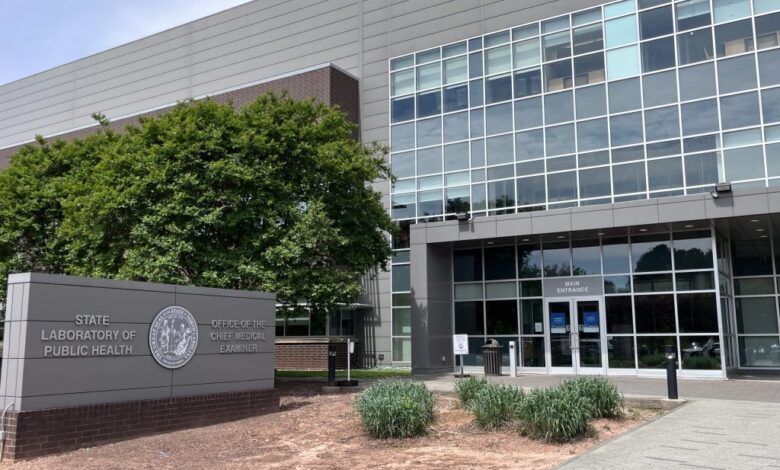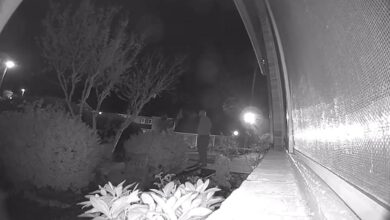Federal cuts threaten to derail NC public health lab upgrades


By Rose Hoban
Work on a major renovation of the State Public Health Laboratory screeched to a halt in late March when the administration of President Donald Trump notified states that the federal government was halting some $11 billion in post-pandemic aid that was scheduled to be distributed to the states.
The state lab, which is six miles from the state Capitol on the outskirts of Raleigh’s inner core, just finished building a new wing and was renovating older labs to expand capacity for advanced testing and data analysis on biologic samples. The goal: to be ready to quickly scale up if another pandemic were to occur.
But progress changed abruptly on March 25, when lab director Scott Shone was notified that any future construction funds from the federal government were stopped as of the prior day.

“We were told retroactively, ‘you’re done,’” Shone told reporters last week as he walked them through parts of the state lab that are dusty construction zones.
The expansions and renovations that are underway were planned, in part, because of the stresses placed on the state lab by the COVID-19 pandemic, where volumes at the lab went from testing maybe a few dozen or a few hundred samples for respiratory illnesses per day to thousands and thousands.
Some parts of the renovation and expansion are completed, but other parts remain unfinished. Plastic tarps hang over entryways, wires hang from open ceilings and bins of files sit in hallways, waiting for construction to resume. Rooms that are almost complete are devoid of lab tables and equipment.
And even though the funds started flowing again once a federal judge issued a temporary restraining order on the Trump administration while a lawsuit by state attorneys general moves through the courts, Shone said that any restart to construction is proceeding gingerly.
“We have not reengaged fully because it would then be on the department, the division… would be on the hook,” he said, for the funding, if the restraining order were not upheld.
One of the positions cut was the money to pay for the construction manager, who Shone was only able to keep on by scraping together money from other lines in his budget.
National emergency spurs development
Even with construction underway, the state lab has continued processing scores of tests daily. While hospitals have their own testing capacity for routine problems and diagnostic testing, the state plays backup for things that are out of the ordinary.
The state lab also provides support to “local health departments for, say, syphilis, gonorrhea, chlamydia, HIV, hepatitis,” Shone said.
Private labs such as Labcorp or Quest are responsible for lots of testing across the state for people who get commercial health insurance coverage — such as Blue Cross Blue Shield or Aetna — through their employers or from the Affordable Care Act marketplace or Medicare Advantage. The state lab can’t directly bill those types of commercial insurers.
“The state laboratory of public health is able to bill Medicaid for those people who are serviced by Medicaid,” Shone said. “The expansion of Medicaid greatly benefitted the people who live in the state because they have access to testing including that right here.”
Part of the public health lab renovations include the new Sequencing and Bioinformatics Response Unit (SaBR) which makes it possible to do advanced genetic analysis of pathogens not readily available at local hospitals and health departments.
“We’re looking at flu, we’re looking at tuberculosis, we’re looking at other infections that typically impact people who are hospitalized or in long term care facilities, and looking at those viruses and bacteria and fungal pathogens at their genetic level, to try to see, can we link them? How are they changing? Are they resistant to antibiotics?” Shone said.

These advanced capabilities are relatively new for North Carolina’s state public health lab. Twenty years ago, the former state lab was located in a smaller, dark windowless downtown building. Leah Devlin, a former state health director, recalled it as “a disgrace.”
“You couldn’t keep all the equipment plugged in at the same time. When the car traffic went by it would rattle the machines, and so you’d have to unplug them and start all over with your testing,” she said.
Devlin recalled giving lawmakers a tour through the building when one older legislator quipped to her, “This is worse than my high school chemistry lab was back when I was at school.”
What changed the fortunes of the state lab were the traumatic events of 2001. Just a month after the Sept. 11 terrorist events, letters laced with anthrax began to arrive at the offices of media outlets and public officials. Five people across the country died and another 17 were made sick by the incidents, which the FBI called, “the worst biological attacks in U.S. history.”
The FBI and the Centers for Disease Control and Prevention swung into action to respond.
The silver lining was that the scientific advances gained from the investigation were “unprecedented and… greatly strengthened the government’s ability to prepare for—and prevent—biological attacks in the future,” according to an FBI fact sheet issued after the attacks.
States needed similar capabilities, the investigation showed.
“The federal government and Congress appropriated a significant amount of funds for the states to build their capacity to respond to an act of bioterrorism,” Devlin said. “It would be used for other emerging disasters and infectious diseases and outbreaks and pandemics and so forth.”
That included creating infrastructure, such as public health labs which are on the frontlines of disease and outbreak surveillance. While building the lab was a joint effort by the state and federal governments, Devlin noted that the General Assembly also eventually provided $101 million in funding for the facility.
The current facility, opened in 2012. Finally, the old Bath Building downtown, which housed the former lab on its top floors, is being demolished.
Not just clawbacks
When word came in late March that the Trump Administration planned to claw back some $11 billion nationwide — including $230 million earmarked for North Carolina — states were told that it was because the money was tied to the pandemic.
“HHS will no longer waste billions of taxpayer dollars responding to a nonexistent pandemic that Americans moved on from years ago,” read a statement from the federal Department of Health and Human Services sent to multiple news outlets.
Shone pointed out that his team was looking ahead. But that means they need to avoid being in a position where they end up struggling the way they did during the pandemic, often with needs as simple as adequate refrigeration.
“We suddenly needed to store supplies to test thousands of samples a day, and to store thousands of samples,” Shone said as he opened the door of a large walk-in refrigeration unit the size of a bedroom. “We had these individual refrigerators and freezers all over the place, we had boxes lining the corridors.”
In the case of another pandemic, the new unit would have adequate space to keep enough samples and testing supplies cold.
The unit wasn’t yet functional, though, because the stop-payment order came before the electricity was hooked up. Likewise, the room surrounding the refrigerator unit was mostly completed, but needed equipment and for electrical fittings to be installed and connected.
Shone said federal dollars were supposed to pay for $2.1 million to complete the lab upgrades and an additional $1.6 million in upgraded lab equipment.
He stood in a mostly empty lab space intended to be “surge space” in case there’s ever another big outbreak.
“We could add this footprint to our testing footprint already. So if we couldn’t do it all in the open lab, we could then bring into this space,” he said, but he pointed out that high-throughput equipment that should be where he was standing was crammed into a smaller, existing, room.
“The flex lab now has become our lifeboat, where you can see there are large pieces of laboratory instruments, in the flex space that are operating all day, every day now to do the testing for infectious diseases that should be relocated back into here.”
Some of those federal dollars would also pay for data modernization efforts.
“Public health in general is very paper-based historically,” Shone said. “You had to fill out paper requisitions to order a test. When was the last time you had to do that? But that’s how public health has been.”
Federal dollars also pay for a courier to pick up samples from North Carolina’s geographically dispersed counties.
“There was a phased approach to all of this, so there was a plan,” Shone said, sweeping an arm around him. “And the plan was coinciding with the funding, right? This funding was supposed to last us until 2026 and 2027.”
He pointed out that the project wasn’t completed yet because they started construction at the tail end of the pandemic, when supply chain issues slowed down construction for many projects.
Shone also said that North Carolina’s lab is not alone in losing funding for upgrades. As a board member for the Association of Public Health Laboratories, he’s heard from “colleagues around the country [who] are also having similar challenges in their states.”
The larger concern is what could potentially lie ahead if there’s an outbreak of some type.
“This is way more than inconvenient. This is dangerous to the future of our ability to respond at any moment,” Shone said. He couldn’t safely put more staff — if needed — into his existing spaces. “We’re one substantial outbreak or surge situation away from not being able to sustain our mission to serve North Carolina.”
The post Federal cuts threaten to derail NC public health lab upgrades appeared first on North Carolina Health News.

